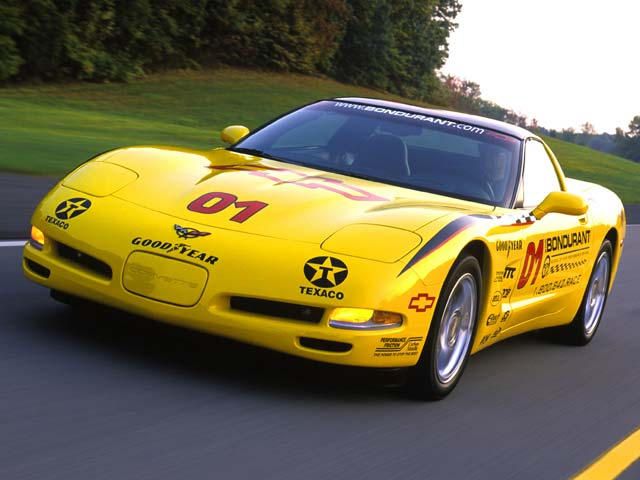The exterior design of the C5 is the closest Corvette stylists ever came to designing a flying saucer. Its elongated slick line, nicely angled curves and huge glass surfaces gave it a fresh look over the outgoing C4 and even a bit idiosyncratic. The styling was also a retreat from the more straight lines of the C4 to the more rounded ones of the C3, only more gently executed. Under the traditional fiberglass body panels lay the chassis and drivetrain of a new configuration.
The gearbox was moved from the front to the rear in order to form a rear mounted transaxle unit which improved weight distribution. The C5 was also "the Corvette that never was." In the beginning of the 1990s, GM suffered one of its cyclical crises and the Corvette project almost fell victim to GM bean counters looking to save money. Fortunately logic prevailed and with a $250 million dollar investment, the C5 was developed with a new chassis that was manufactured using hydroform technology. That enabled a much stronger chassis than before and the convertible variant became almost as twist resistant as the coupe.
The C5 also boasted the longest wheelbase (104.7 inches) of all previous Corvette generations, although the overall length of 179.7 inches made it 3.1 inches shorter than the C4. For the first time ever, Corvette buyers had a choice of three body style variants. In addition to the coupe with the removable center section and the convertible (which featured outside access to the trunk for the first time since 1962) a hardtop version was launched in the U.S. market in 1999. Not only did the C5 have an all-new design, it also came with the 5.7-liter V8 engine designed by chief engineer Dave Hill and his team.
The so-called LS1 unit was an all-aluminum construction that delivered 344hp at just 5,400 rpm. Peak torque of 356 lb-ft was available at 4,200 rpm. The maximum possible engine speed proves the sturdiness of the optimized valve operation; the engine, positioned behind the front axle so as to balance the weight distribution, reaches 6,000 rpm with ease. The C5 made the dash from zero to 62 mph in just 4.7 seconds. Power was conveyed to the rear axle via a choice of a six-speed manual or four-speed electronic automatic transmission.
The C5's interior was also pure sports car. The leather seats featured power controls for length and height as well as electronically adjustable lumbar support and side bolsters. There was also a height-adjustable steering column that allowed for every driver to find an ideal seating position. The electronic memory option allows as many as three different drivers to recall their preset configuration for seating position, wing mirror angle, dual-zone climate control settings and even their favorite radio stations on the standard Bose sound system.
Another technical highlight was the head-up display, which projects the most important indicators, such as speed and rpm level, onto a special layer on the lower half of the windscreen. An additional safety feature was the sensor-assisted Twilight Sentinel system, which automatically activates the headlamps at the outbreak of darkness. Production ended in 2004 just Chevrolet was putting the finishing touches on its replacement, the C6.

